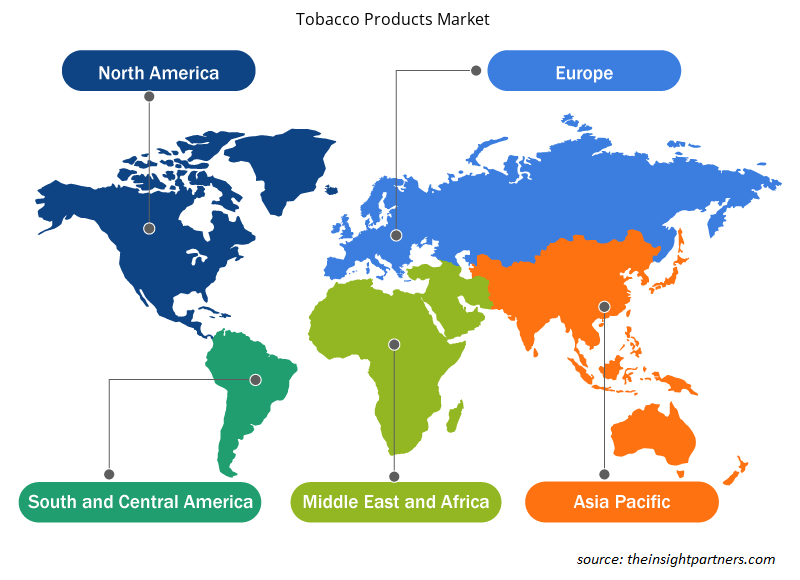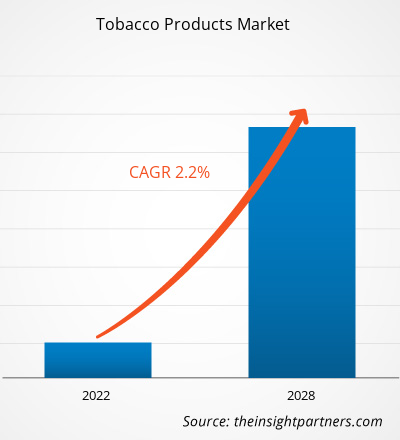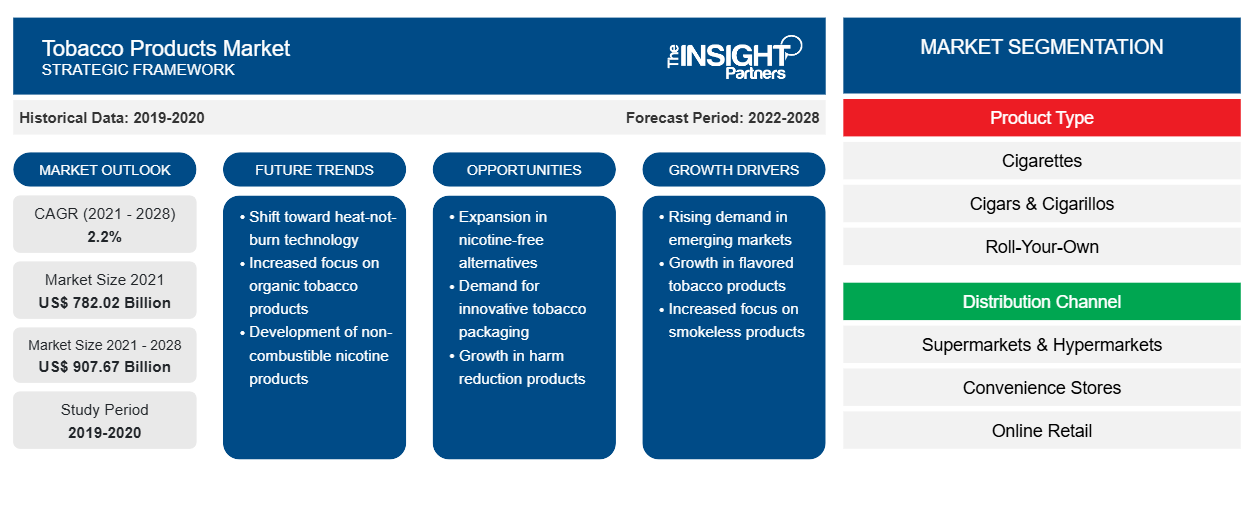Der Markt für Tabakprodukte soll von 782.022,19 Millionen US-Dollar im Jahr 2021 auf 907.665,43 Millionen US-Dollar im Jahr 2028 anwachsen. Von 2021 bis 2028 wird mit einer durchschnittlichen jährlichen Wachstumsrate von 2,2 % gerechnet.
Tabakblätter verschiedener Sorten, wie Virginia und Burley, werden gemischt, um Produkte wie Zigaretten , Zigarren und Zigarillos sowie Tabak zum Selbstdrehen herzustellen. Der Konsum von Tabak und verwandten Produkten stieg während der Zeit der wirtschaftlichen Rezession weltweit aufgrund von Börseneinbrüchen und Zwangsversteigerungen sowie dem Stress durch Entlassungen, der viele Menschen dazu veranlasste, Zuflucht im Rauchen zu suchen. Tabak ist eine der am häufigsten verwendeten Suchtmittel der Welt. Er trägt auch zum Großteil der Steuereinnahmen verschiedener Länder in Industrie- und Entwicklungsländern bei.
Der asiatisch-pazifische Raum hatte 2020 den größten Anteil am Markt für Tabakprodukte , während für den Nahen Osten und Afrika im Prognosezeitraum ein signifikanter CAGR auf dem Markt erwartet wird. Die wichtigsten Akteure auf dem Markt für Tabakprodukte weiten ihre Aktivitäten im Nahen Osten und in Afrika aufgrund des potenziellen Kundenstamms, günstiger Gesetze und einer sich in der gesamten Region schnell entwickelnden Einzelhandelslandschaft aus.
Passen Sie diesen Bericht Ihren Anforderungen an
Sie erhalten kostenlos individuelle Anpassungen an jedem Bericht, einschließlich Teilen dieses Berichts oder einer Analyse auf Länderebene, eines Excel-Datenpakets sowie tolle Angebote und Rabatte für Start-ups und Universitäten.
-
Holen Sie sich die wichtigsten Markttrends aus diesem Bericht.Dieses KOSTENLOSE Beispiel umfasst eine Datenanalyse von Markttrends bis hin zu Schätzungen und Prognosen.
Auswirkungen der COVID-19-Pandemie auf den Markt für Tabakprodukte
Die COVID-19-Pandemie brachte Anfang 2020 für viele Branchen beispiellose Herausforderungen mit sich. Lockdowns, Grenzbeschränkungen, Reiseverbote, Produktionsunterbrechungen und andere Sicherheitsmaßnahmen, die von Regierungen gemäß den Richtlinien der WHO und der nationalen Gesundheitsministerien eingeführt wurden, behinderten die Produktionsabläufe. Andererseits waren laut Studien des American College of Physicians die Zigarettenverkäufe in den USA während der ersten 16 Monate der COVID-19-Pandemie höher als erwartet. Die Mehrheit der Tabakunternehmen verzeichnete während der Pandemie einen Anstieg der Nachfrage nach rauchfreien oder erhitzten Tabakprodukten und Kautabakprodukten. Aufgrund der Reiseverbote mussten sie jedoch einen leichten Rückgang der Einzelhandelsreiseverkäufe hinnehmen.
Markteinblicke
Steigende Nachfrage nach nicht brennbaren Tabakprodukten treibt Marktwachstum an
Aufgrund der zunehmenden gesundheitlichen Bedenken im Zusammenhang mit dem Konsum brennbarer Tabakprodukte haben Regierungen Unternehmen ermutigt, verschiedene Gesetze und Vorschriften einzuführen, um den Tabakkonsum unter Kontrolle zu halten. Sie haben die Steuern auf brennbaren Tabak erhöht und die Preise für nicht brennbaren Tabak gesenkt. Dies führte zu einer stärkeren Akzeptanz nicht brennbarer Produkte wie E-Zigaretten. So verfolgte die britische Regierung beispielsweise einen ganzheitlichen Ansatz, indem sie die Steuern auf brennbare Tabakprodukte deutlich erhöhte und die Steuern auf nicht brennbare Produkte senkte. Dies erhöhte die Akzeptanz von E-Zigaretten auf dem britischen Markt und reduzierte die Raucherquote im Land deutlich. Hersteller haben auch orale, nicht brennbare oder rauchfreie Tabakprodukte in der Kategorie der Produkte mit reduziertem Risiko (RRPs) entwickelt.
Einblicke in Produkttypen
Basierend auf dem Produkttyp ist der Markt für Tabakprodukte in Zigaretten, Zigarren und Zigarillos, selbstgedrehte Zigaretten und andere unterteilt. Das Segment der anderen Tabakprodukte wird im Prognosezeitraum voraussichtlich die höchste durchschnittliche jährliche Wachstumsrate verzeichnen. Dieses Segment umfasst E-Zigaretten, Vapes, Snus und lösliche Tabakprodukte. Das zunehmende Bewusstsein für die Gefahren brennbarer Tabakprodukte treibt die Nachfrage nach nicht brennbaren Tabakprodukten wie E-Zigaretten, Vapes und Kautabakprodukten an.
Einblicke in Vertriebskanäle
Basierend auf den Vertriebskanälen wurde der Markt für Tabakprodukte in Supermärkte und Hypermärkte, Convenience Stores, Online-Einzelhandel und andere segmentiert. Das Segment Online-Einzelhandel wird im Prognosezeitraum voraussichtlich die höchste durchschnittliche jährliche Wachstumsrate des Marktes verzeichnen. Der Online-Einzelhandel bietet den Benutzern ein bequemes Einkaufserlebnis, gefolgt von einer vereinfachten Produktlieferung. Online-Einzelhandelsgeschäfte bieten eine breite Produktpalette zu hohen Rabatten; außerdem können Verbraucher gewünschte Produkte bequem aus der Ferne kaufen. Hauslieferdienste ermutigen viele Verbraucher, über E-Commerce-Portale einzukaufen.
Zu den wichtigsten Akteuren auf dem Markt für Tabakprodukte zählen Altria Group, Inc.; British American Tobacco plc; Swedish Match AB; ITC Ltd.; Japan Tobacco International; Imperial Brands; Philip Morris Products SA; Vector Group LTD.; Pyxus International, Inc.; und China Tobacco International (HK) Company Limited. Diese Akteure entwickeln Produkte mit reduzierten Gesundheitsrisiken, um den neuen Verbrauchertrends gerecht zu werden und gleichzeitig die gesetzlichen Rahmenbedingungen einzuhalten. Sie sind an Fusionen und Übernahmen, Geschäftserweiterungen und Partnerschaften beteiligt, um ihren Marktanteil zu vergrößern.
Regionale Einblicke in den Markt für Tabakprodukte
Die regionalen Trends und Faktoren, die den Tabakwarenmarkt im Prognosezeitraum beeinflussen, wurden von den Analysten von Insight Partners ausführlich erläutert. In diesem Abschnitt werden auch die Marktsegmente und die Geografie von Tabakwaren in Nordamerika, Europa, im asiatisch-pazifischen Raum, im Nahen Osten und Afrika sowie in Süd- und Mittelamerika erörtert.

- Erhalten Sie regionale Daten zum Tabakmarkt
Umfang des Marktberichts zu Tabakprodukten
| Berichtsattribut | Details |
|---|---|
| Marktgröße im Jahr 2021 | 782,02 Milliarden US-Dollar |
| Marktgröße bis 2028 | 907,67 Milliarden US-Dollar |
| Globale CAGR (2021 - 2028) | 2,2 % |
| Historische Daten | 2019-2020 |
| Prognosezeitraum | 2022–2028 |
| Abgedeckte Segmente |
Nach Produkttyp
|
| Abgedeckte Regionen und Länder |
Nordamerika
|
| Marktführer und wichtige Unternehmensprofile |
|
Dichte der Marktteilnehmer für Tabakprodukte: Auswirkungen auf die Geschäftsdynamik verstehen
Der Markt für Tabakprodukte wächst rasant, angetrieben durch die steigende Nachfrage der Endverbraucher aufgrund von Faktoren wie sich entwickelnden Verbraucherpräferenzen, technologischen Fortschritten und einem größeren Bewusstsein für die Vorteile des Produkts. Mit steigender Nachfrage erweitern Unternehmen ihr Angebot, entwickeln Innovationen, um die Bedürfnisse der Verbraucher zu erfüllen, und nutzen neue Trends, was das Marktwachstum weiter ankurbelt.
Die Marktteilnehmerdichte bezieht sich auf die Verteilung von Firmen oder Unternehmen, die in einem bestimmten Markt oder einer bestimmten Branche tätig sind. Sie gibt an, wie viele Wettbewerber (Marktteilnehmer) in einem bestimmten Marktraum im Verhältnis zu seiner Größe oder seinem gesamten Marktwert präsent sind.
Die wichtigsten auf dem Markt für Tabakprodukte tätigen Unternehmen sind:
- Altria Group, Inc.
- British American Tobacco plc.
- Swedish Match AB
- ITC Ltd.
- Japan Tobacco International
Haftungsausschluss : Die oben aufgeführten Unternehmen sind nicht in einer bestimmten Reihenfolge aufgeführt.

- Erhalten Sie einen Überblick über die wichtigsten Akteure auf dem Markt für Tabakprodukte
Bericht-Spotlights
- Fortschrittliche Branchentrends auf dem Tabakmarkt helfen den Akteuren bei der Entwicklung wirksamer langfristiger Strategien
- Einführung von Geschäftswachstumsstrategien zur Sicherung des Wachstums in entwickelten und sich entwickelnden Märkten
- Quantitative Analyse des Tabakproduktmarktes von 2019 bis 2028
- Schätzung der weltweiten Nachfrage nach Tabakprodukten
- Porters Fünf-Kräfte-Analyse zur Veranschaulichung der Wirksamkeit der in der Branche tätigen Käufer und Lieferanten
- Aktuelle Entwicklungen zum Verständnis des wettbewerbsorientierten Marktszenarios
- Markttrends und -aussichten sowie Faktoren, die das Wachstum des Tabakproduktemarktes bestimmen
- Unterstützung im Entscheidungsprozess durch Aufzeigen von Marktstrategien, die das kommerzielle Interesse untermauern und zum Marktwachstum führen
- Größe des Tabakmarktes an verschiedenen Knotenpunkten
- Detaillierte Übersicht und Segmentierung des Marktes sowie der Dynamik der Tabakindustrie
- Ausmaß des Wachstums in verschiedenen Regionen mit vielversprechenden Wachstumschancen
- Historische Analyse (2 Jahre), Basisjahr, Prognose (7 Jahre) mit CAGR
- PEST- und SWOT-Analyse
- Marktgröße Wert/Volumen – Global, Regional, Land
- Branchen- und Wettbewerbslandschaft
- Excel-Datensatz
Aktuelle Berichte
Erfahrungsberichte
Grund zum Kauf
- Fundierte Entscheidungsfindung
- Marktdynamik verstehen
- Wettbewerbsanalyse
- Kundeneinblicke
- Marktprognosen
- Risikominimierung
- Strategische Planung
- Investitionsbegründung
- Identifizierung neuer Märkte
- Verbesserung von Marketingstrategien
- Steigerung der Betriebseffizienz
- Anpassung an regulatorische Trends























 Kostenlose Probe anfordern für - Markt für Tabakprodukte
Kostenlose Probe anfordern für - Markt für Tabakprodukte